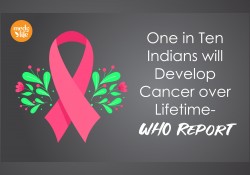
WHO Report Says-One in Ten Indians will Develop Cancer over Lifetime
06-02-2020 | Posted By: Admin | 2116 View(s)
Here are some Statistics as per The World Cancer Report
-In 2018 alone there were about 1.16 million new cases
-784000 Deaths
-2.26 million 5-Year Prevalent Cases in India’s population of 1.35 Billion
-As per the WHO, one in 10 Indians will develop Cancer during their lifetime and one in 15 will die from the disease
In India, the six most common cancer types were
1.Breast Cancer (162,500 cases)
2.Oral cancer (120,000 cases)
3.Cervical cancer (97,000 cases)
4.Lung cancer (68,000 cases)
5.Stomach cancer (57,000 cases)
6.Colorectal cancer (57,000)

Together, these account for 49% of all new cancer cases.
Of the 570,000 new cancer cases in men, oral cancer (92,000), lung cancer (49,000), stomach cancer (39,000), colorectal cancer (37,000), and oesophageal cancer (34,000) account for 45% of cases.
The report added that of the 587,000 new cancer cases in women, breast cancer (162,500), cervical cancer (97,000), ovarian cancer (36,000), oral cancer (28,000), and colorectal cancer (20,000) account for 60% of cases.
Cancer patterns in India are dominated by a high burden of tobacco-related head and neck cancers, particularly oral cancer, in men and of cervical cancer in women; both of these cancer types are associated with lower socio-economic status, the report said. The burden of cancer types, such as breast cancer and colorectal cancer, associated with overweight and obesity, lower levels of physical activity, and sedentary lifestyles is increasing and these cancer types are associated with higher socio-economic status.
“During the past two decades, India has had one of the world’s best performing and most stable economies, which has grown by more than 7% annually in most years. This economic development has given rise to vast socio-economic changes, with an increasing risk of non-communicable diseases, including cancer, ad significant disparities in access to cancer prevention and control services,” the report said.
WHO warned that global cancer rates could rise by 60% over the next 20 years unless cancer care is ramped up in low and middle-income countries. Less than 15% of these nations offer comprehensive cancer treatment services through their public health systems, according to the U.N. agency. At least 7 million lives could be saved over the next decade, by identifying the most appropriate science for each country situation, by basing strong cancer responses on universal health coverage, and by mobilizing different stakeholders to work together, WHO Director-General Tedros Adhanom Ghebreyesus said.
The report said about 80% of the world’s smokers live in low and middle-income countries. In addition, 64% of the world’s daily smokers live in only 10 countries and more than 50 per cent of the world’s male smokers live in three countries: China, India, and Indonesia. There are currently 164 million users of smokeless tobacco, 69 million smokers, and 42 million smokers and chewers in India. More than 90% of patients with oral cancer have low or lower-middle socio-economic status. Tobacco-related cancers account for 34-69% of all cancers in men, they constitute 10-27% of all cancers in women in most regions in India. The incidence of colorectal cancer is increasing in the most developed States in India and in urban populations.
Increasing trend
“There is a clear increasing trend in the incidence rates of breast cancer across the country, with an annual percentage increase that ranges from 1.4% to 2.8% and is more pronounced in urban areas than in rural areas. Incidence rates are also increasing for cancer types associated with overweight and obesity and lower levels of physical activity, such as colorectal cancer, uterine cancer, ovarian cancer and prostate cancer,” the report said
The report noted that there is a clear decreasing trend in the incidence rates of cervical cancer in most regions in India (annual percentage change, -2.0% to -3.5%), with age-standardized incidence rates as low as 6 per 1,00,000 in women in Kerala. India accounts for about one-fifth of the global burden of cervical cancer, despite decreasing incidence rates in several regions of the country. Thus, the elimination of cervical cancer in India will have a major impact on the global elimination of the disease as a public health problem. Cervical cancer disproportionately affects women with lower socio-economic status, who are at a considerable disadvantage in the availability of and access to public health services for prevention and early detection, and therefore this is an equity issue.
IARC Director Elisabete Weiderpass observed that high-income countries have adopted prevention, early diagnosis and screening programmes, which together with better treatment, have contributed to an estimated 20% reduction in the probability of premature mortality between 2000 and 2015, but low-income countries only saw a reduction of 5%.










